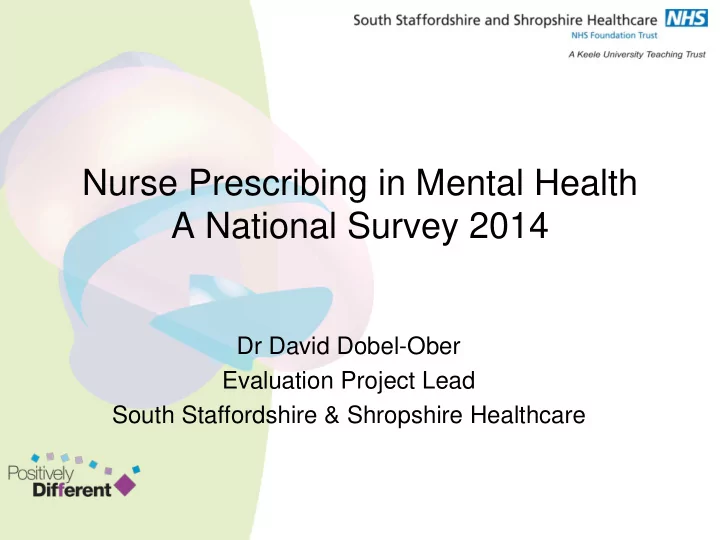

Nurse Prescribing in Mental Health A National Survey 2014 Dr David Dobel-Ober Evaluation Project Lead South Staffordshire & Shropshire Healthcare
Background Non medical prescribing / mental health nursing: • Supplementary prescribing 2003 • Independent prescribing 2006 • Controlled drugs (IP) 2012
Methods • Follow-up (2005 – 2008 – 2014) • Postal questionnaire to Directors of Nursing • Responding Trusts (response rates): 2005 45 54% 2008 39 59% 2014 39 75% • Non-responding Trusts might have less interest / lower numbers / information
Active prescriber? • No clear definition • This survey: trained & registered as prescribers with NMC & described as supplementary or independent prescriber • Non-active prescribers under-reported – Not on Trusts registers – Change of role / employer – Overall increase in numbers
Overall increase in numbers 963 603 213 2005 2008 2014
Distribution by Trusts (Based on 32 Trusts) Mean Non active 8 Independent 21 Supplementary 6 In training 4
Areas of practice / prescribing status Other (MH) 2008 2014 Prison Forensic Supplementary Series1 Primary care Older people inpatient Acute inpatient Independent Series2 CAMHS Early Intervention in psychosis Assertive outreach teams Crisis/home treatment Older people community Drug and alcohol CMHT 100 50 0 50 100 150 200
Strategic development: identifying roles Formal processes/policies: Yes = 74% Mapping No needs in information progress 6 5 Not strategic (governance) Service re- 5 design 9 Service led 3 Linked to care cluster 1
Strategic development: identifying roles • 15 Trusts integrated NP to service re-design / development (38%) • 24 Trusts described service-led processes or based on governance (62%) ‘We have a number of places and then a process whereby nurses are asked to identify: improvements in patients outcomes; impact on service delivery in terms of productivity & efficiency.’ • In 2008 only 7 Trusts (18%) described process based on service needs; the rest was based on candidates’ skills.
Strategic development: Embedding roles 77% Trusts routinely amend job descriptions to reflect NP practice in role (n=30) 58% Recruitment to position vacated by NP: NMP qualification included in job specification? 29% 21% 13% essential desirable & training desirable only case by case expected
Governance NMP lead (all Trusts) • Typically nurse 36 nurses 5 pharmacists • Seniority: Band 7 (n=1) Band 8a/b (n=23) Band 8c/d (n=10) Director / Deputy Director (n=5) • Most dedicate less than 1 day/week to NP (2 Trusts = whole time) • The most NP active Trusts tend to have a lead in a lower band with more dedicated time
Governance Register of NMP – 2008: 20% – 2014: 100% – Varied content – Varied criteria to remain on register
Register: content Record of CPD 16 Active status / Regular on-going prescribing practice 11 Evidence of supervision by medical prescriber 9 NMC registration 8 Competency framework / adherence to policies / professional standards 7 Current employee 6 Audit of practice 5 Submission of scope of practice 4 In a role that support prescribing / Clinical position 4 Annual approval to practice 4 Declaration of active practice / intention to practice (annual) 3 Prescribing portfolio up to date 3
Registration? Evidence of CPD 14 Active status 10 receive clinical supervision 9 NMC registration 8 Submit scope of practice 7 Employed by Trust 5 Regular audit 5 Annual competency framework 2 In a clinical role 2 Portfolio 2 Lowest minimum requirement: 3 = remain employed by the Trust 3 = prescribe actively
Active prescriber? • 4 Trusts have an operational definition: At least 1 prescription every: 3 months (n=2) 12 months (n=1) weekly (n=1) • Two respondents indicated that providing advice and guidance could be considered as active prescribing.
Workforce development (Identifying) & selecting candidates • No process to identify candidates • All Trusts have processes in place to ensure candidates: – Meet the minimum mandatory requirements (academic and professional) – Would be in a position to use prescribing skills once qualified
Workforce development Additional requirements prior to training: • Psychopharmacology 5 • Medication management 4 • PGD 1 • Diagnosis & assessment 3 • Numeracy skills 4 • Having studied at level 6/7 in the previous two years 1
Workforce development: promoting transition from SP to IP Formal strategies 17 Informal strategies 14 6/12 months SP practice 8 probationary period IP with mentorship 8 Formal competency assessment 2 Minimum number of prescriptions & appropriate competency 1 Psychopharmacology course 1 Individual review 6 Individual formulary 2
Workforce development: CPD Formal CPD programme 34 (87%) Forum 15 Education sessions 11 Local conference 8 Group supervision 5 Competency framework 3 Portfolio 2 Annual audit of practice 1
Workforce development: seniority • Band 6 & above (strictly) 14 • Band 6 & above (flexible) 9 • No minimum requirement 8 • Band 6 = SP Band 7 = IP 1
Workforce development: Career progression & remuneration • Generally no direct link between NP career progression • Two Trusts indicated that senior nursing roles were expected to be active NPs (e.g. clinical nurse specialist, nurse consultant or advanced practitioner) • One Trust considering introducing an annual retainer or sessional payment for NP operating clinics
Key points • Significant development in some Trusts • Stable/small scale in many • NP still most used CMHT, Drug & Alcohol and Older People Community • Marked development in CRHT, CAMHS and Forensic Services
Key points • IP is more common than SP • No strong link between remuneration/career progression and NP • Stronger strategic approach to NP but many Trusts still relying on individual interest • No clear definition of active nurse prescriber. Non-active NP likely to be under-reported
References 2005 survey Gray R, Parr A-M, Brimblecombe N. Mental health nurse supplementary prescribing: mapping progress 1 year after implementation. Psychiatr Bull . 2005;(29):295 – 297. 2008 survey Dobel-Ober D, Brimblecombe N, Bradley E. Nurse prescribing in mental health: national survey. J Psychiatr Ment Health Nurs . 2010;17(6):487 – 493.
Recommend
More recommend